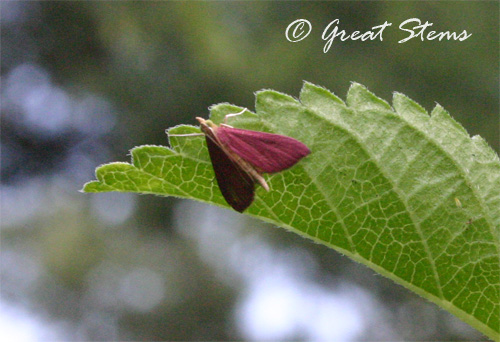This weekend’s habitat event was helping install wildlife-friendly native plants to create a beginning wildlife garden at the Austin Groups for the Elderly building, known locally as the AGE building. This non-profit organization “empowers caregivers, the elderly and their families through education, advocacy, resources and support” and is a daytime care and resource facility for older members of our community.

Habitat volunteers from the City of Austin, Travis Audubon, and NWF, along with friends and family and AGE staff, got right to work. The first task was scraping out clover and grass from the future beds.
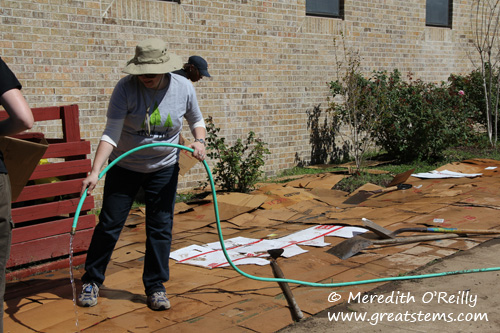
Next, volunteers watered the soil a bit, then placed a carefully arranged layer of cardboard, which also was made wet.


On top of that, we layered soil where necessary, and topped it all with single-shred mulch, kept thin under the trees. This method of lawn reduction is effective and remarkably simple.
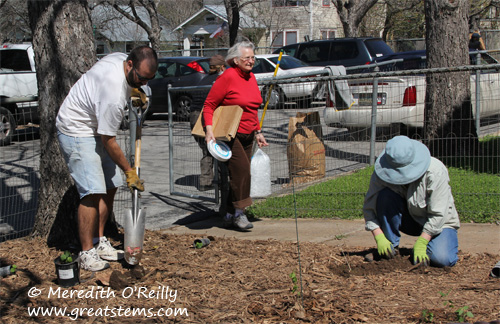
The final step was adding plants, including Mexican Buckeye, Shrubby Boneset, Texas Mulberry, Evergreen Sumac, Turk’s Cap, Crossvine, and others. The plants were small, but small is all it takes!
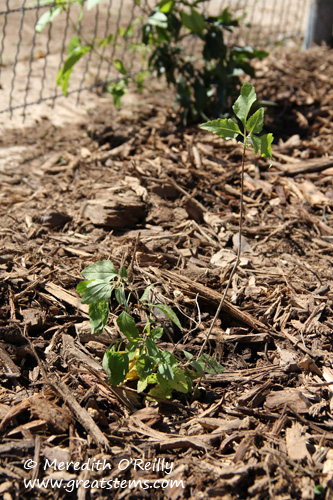 The garden is a favorite sitting area for many AGE members, and the new habitat will attract many butterflies and birds for visitors’ viewing pleasure. The building also houses our Travis Audubon office — so we’re extra glad to have a new habitat right outside!
The garden is a favorite sitting area for many AGE members, and the new habitat will attract many butterflies and birds for visitors’ viewing pleasure. The building also houses our Travis Audubon office — so we’re extra glad to have a new habitat right outside!
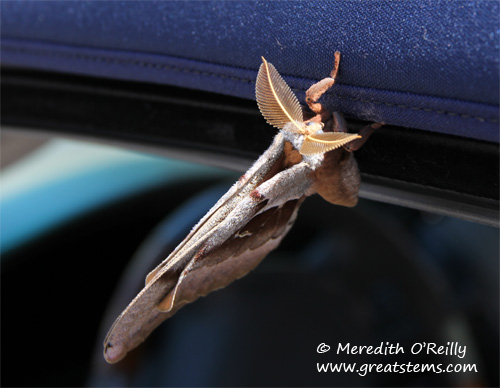 As we were getting ready to leave, my husband called me over to see a creature hanging upside-down from the car of a volunteer. It turned out to be a gorgeous Lepidopteran.
As we were getting ready to leave, my husband called me over to see a creature hanging upside-down from the car of a volunteer. It turned out to be a gorgeous Lepidopteran.
The volunteer was quite concerned, and to be honest, from a distance it really did look like a bat was hanging from his window. But I rushed right over to rescue it, and it proved to be a stunning, yet frail, Polyphemus moth. Those bushy antennae you see are an indication that this moth also happened to be male.
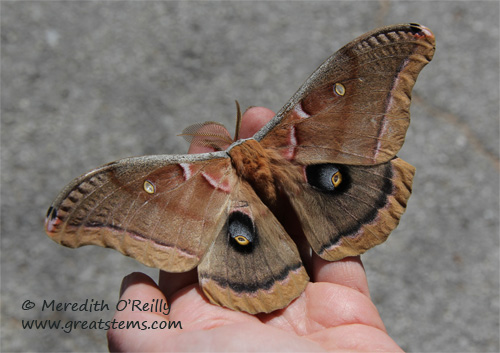
There are a number of threats to this beautiful species, but at least they have a variety of host plants, as well as those spectacular and “scary” eye spots, to give them a better chance at making it. The tiny little upper spots on the forewings are actually transparent. We checked.
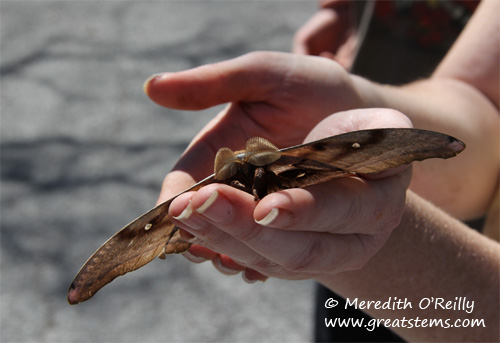 Polyphemus moths have an average wing span of about 6 inches. As adults, they also have reduced mouth parts, meaning that they can’t eat, so they have one job to focus on: reproduction. The feathery antennae of the males are used to detect the scent of unmated females. Whether the antennae also make the male moths look sexy to females, I cannot attest. But for this female, I think they look pretty cool. Not getting to eat means something else — the moths have a short lifespan of less than a week.
Polyphemus moths have an average wing span of about 6 inches. As adults, they also have reduced mouth parts, meaning that they can’t eat, so they have one job to focus on: reproduction. The feathery antennae of the males are used to detect the scent of unmated females. Whether the antennae also make the male moths look sexy to females, I cannot attest. But for this female, I think they look pretty cool. Not getting to eat means something else — the moths have a short lifespan of less than a week.
As it had trouble flying, It seemed to me that this little (big) moth was on its last wing, so to speak, so I gently kept it protected and decided to bring it home with us. As it turns out, the moth wasn’t as frail as we thought.
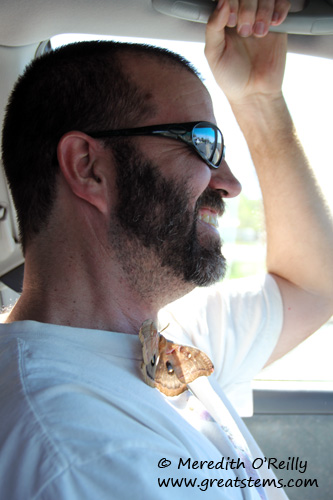 Perhaps because it was darker in the car, the moth came to life once we got moving on the road. By the time we were on the highway, it was fluttering all about, making for quite an interesting drive home. At one point, the Polyphemus moth decorated my husband as a bowtie.
Perhaps because it was darker in the car, the moth came to life once we got moving on the road. By the time we were on the highway, it was fluttering all about, making for quite an interesting drive home. At one point, the Polyphemus moth decorated my husband as a bowtie.
For its own safety, we didn’t want to release the moth until we actually arrived home to our wooded habitat, but in the meantime, it kept us busy in the car, as we had to make sure it stayed safe there, too.
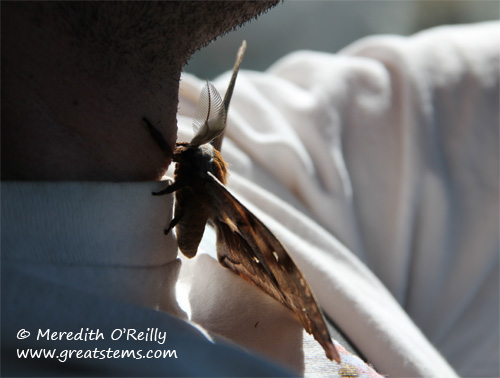 For quite a bit of the drive, the moth seemed particularly fond of my husband (who was under strict orders not to react to the tickling sensation, nor to panic and cause a wreck). My husband replied, “Finally, there’s an animal who’s not afraid of me!” How my husband manages to seem fearsome in our happy zoo is beyond me, but our skittish cat Cricket in particular still gives him the wary eye. Not many men can boast that they’ve had a Polyphemus moth rest on their Adam’s Apple, but my husband can. Let me just add that driving in a car with a fluttering giant silk moth is perhaps a “Don’t Try This
For quite a bit of the drive, the moth seemed particularly fond of my husband (who was under strict orders not to react to the tickling sensation, nor to panic and cause a wreck). My husband replied, “Finally, there’s an animal who’s not afraid of me!” How my husband manages to seem fearsome in our happy zoo is beyond me, but our skittish cat Cricket in particular still gives him the wary eye. Not many men can boast that they’ve had a Polyphemus moth rest on their Adam’s Apple, but my husband can. Let me just add that driving in a car with a fluttering giant silk moth is perhaps a “Don’t Try This at Home in Your Car” scenario.
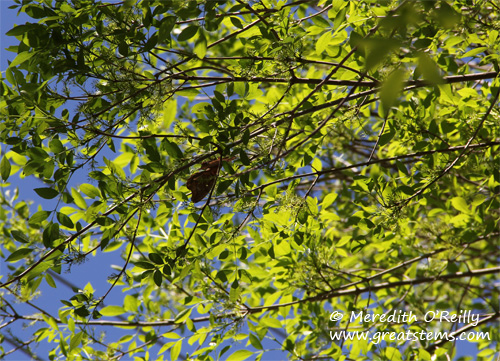 Upon our return home, I carefully gathered up the Polyphemus moth, bid it a fond farewell and good luck, and opened my hands to the sky. The moth flew up to the ash tree above, where it rested for much of the afternoon. What an adventure we all had!
Upon our return home, I carefully gathered up the Polyphemus moth, bid it a fond farewell and good luck, and opened my hands to the sky. The moth flew up to the ash tree above, where it rested for much of the afternoon. What an adventure we all had!
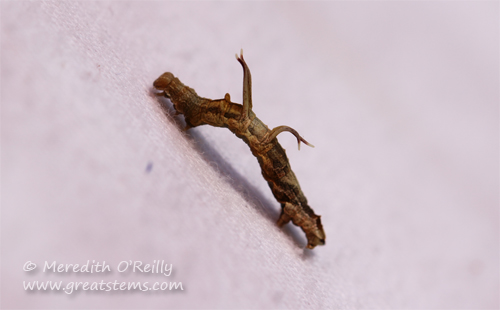
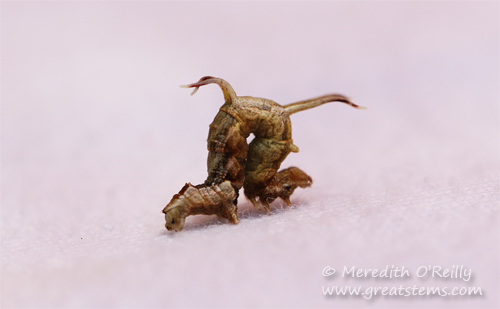 As near as I can tell, this inchworm is one of just a few species that have filaments — in the United States, there are primarily three recognized species. Ours appears to be Nematocampa resistaria, or Horned Spanworm Moth.
As near as I can tell, this inchworm is one of just a few species that have filaments — in the United States, there are primarily three recognized species. Ours appears to be Nematocampa resistaria, or Horned Spanworm Moth.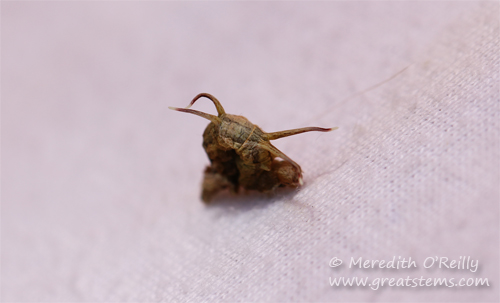
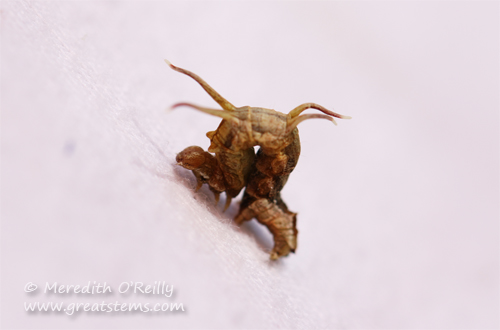 The length of the pale-tipped filaments on our little inchworm indicate that it was actually a little concerned by our presence (not that we were the ones invading its space this time, mind you — it was the other way around!). When relaxed, the inchworm’s filaments aren’t quite as long. When alarmed, it pumps hemolymph into them, which extends them — like spider legs, oooOOOoooh.
The length of the pale-tipped filaments on our little inchworm indicate that it was actually a little concerned by our presence (not that we were the ones invading its space this time, mind you — it was the other way around!). When relaxed, the inchworm’s filaments aren’t quite as long. When alarmed, it pumps hemolymph into them, which extends them — like spider legs, oooOOOoooh.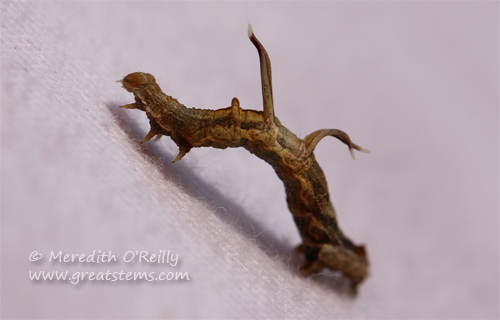 Remember, these little guys and other caterpillars have an important role in the ecosystem as food sources for birds and other animals — don’t squish them!
Remember, these little guys and other caterpillars have an important role in the ecosystem as food sources for birds and other animals — don’t squish them!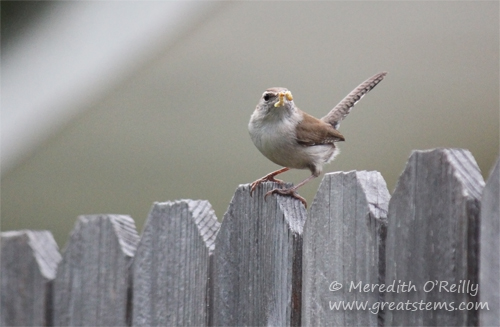
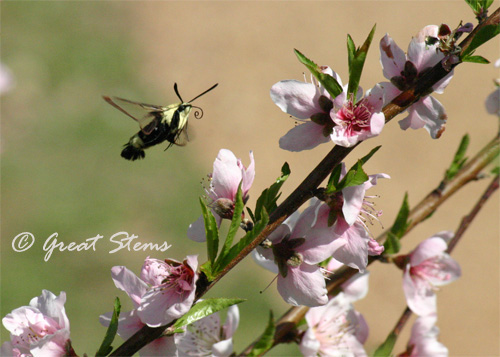
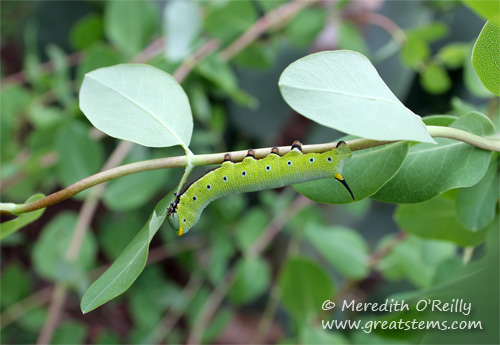
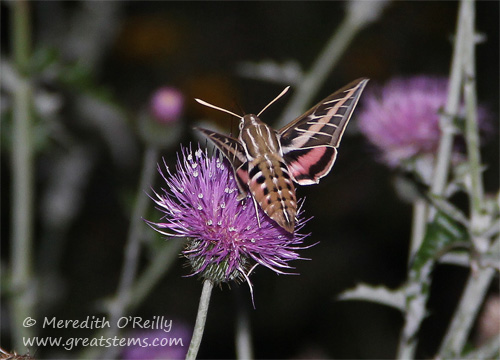
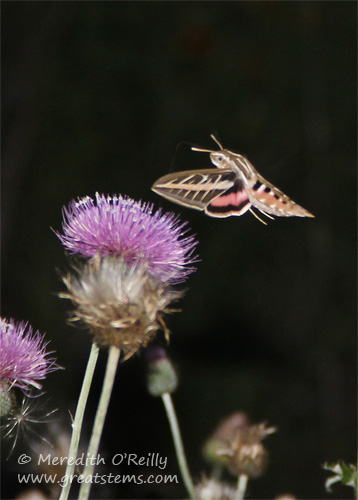
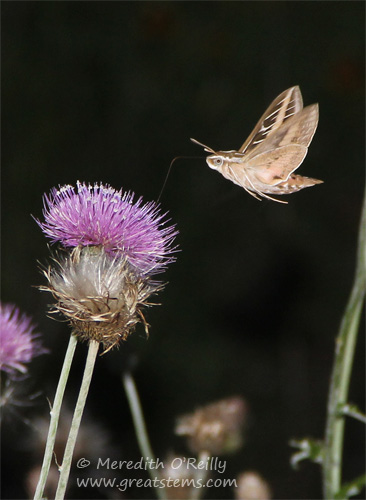
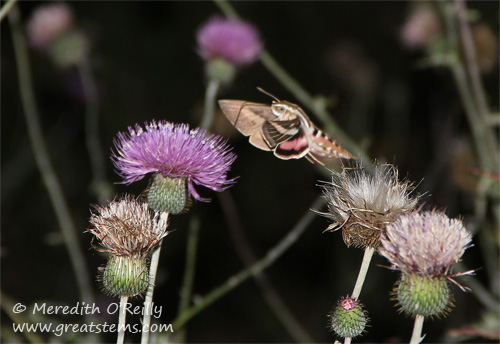
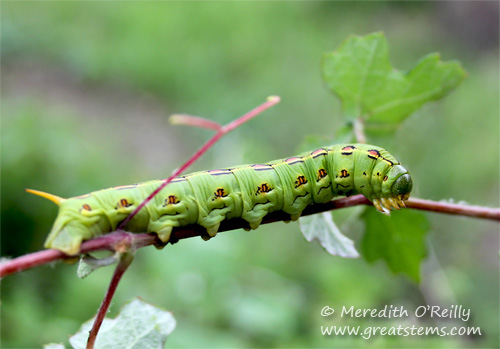
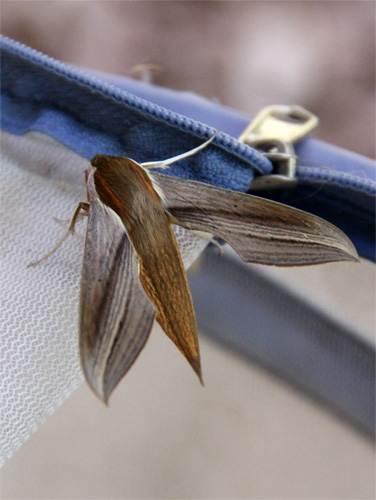
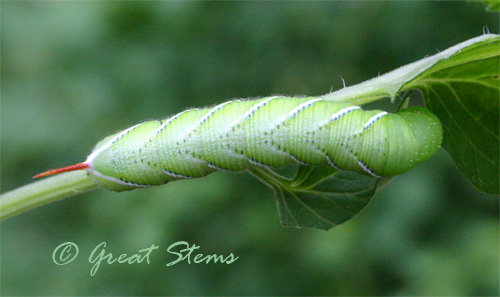
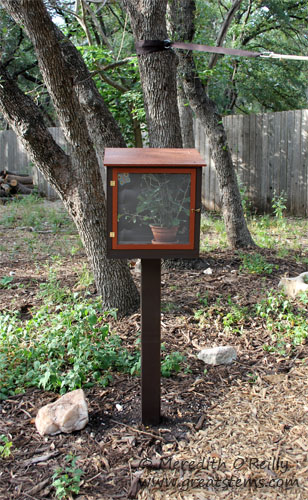
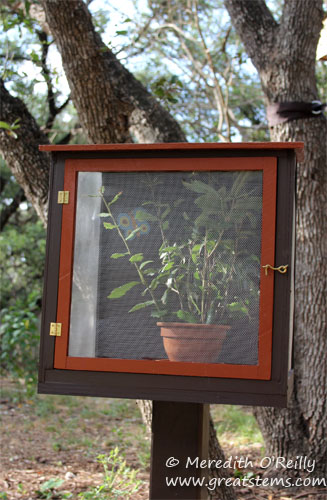
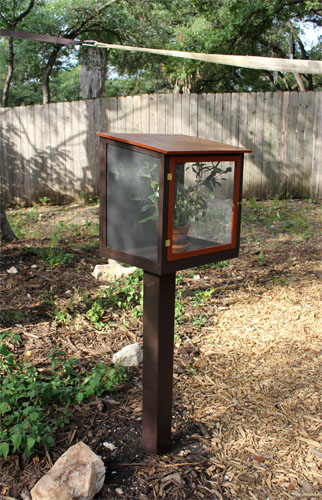
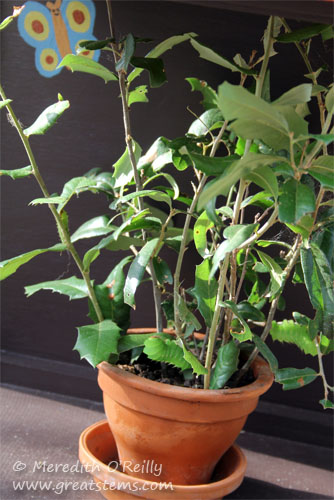
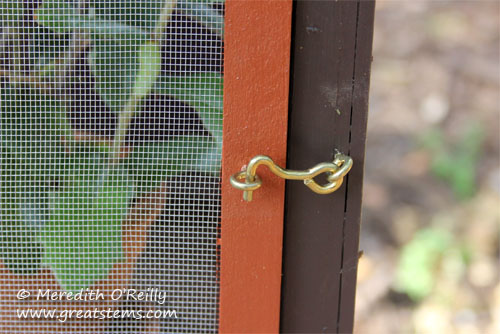
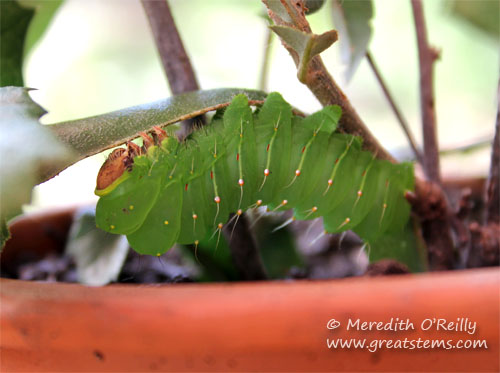
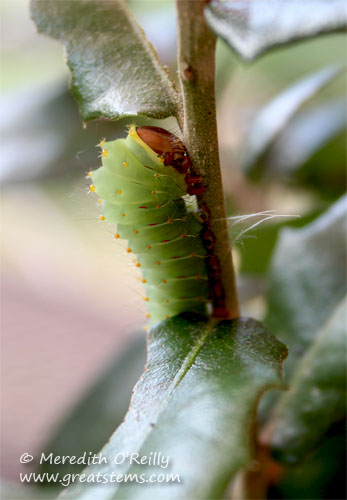
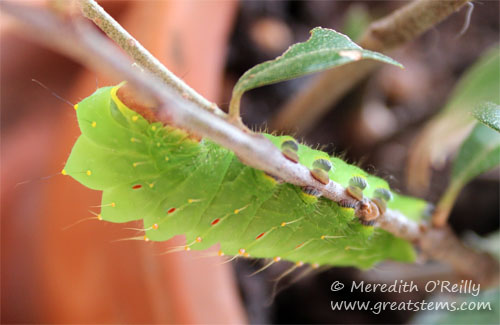
 You might recall the
You might recall the 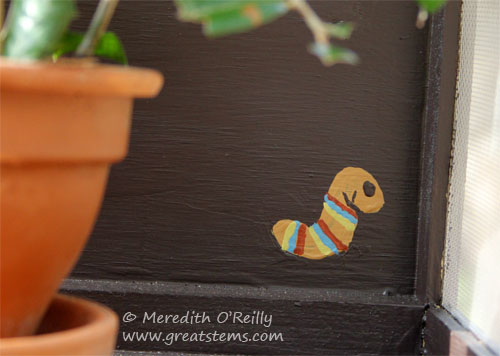


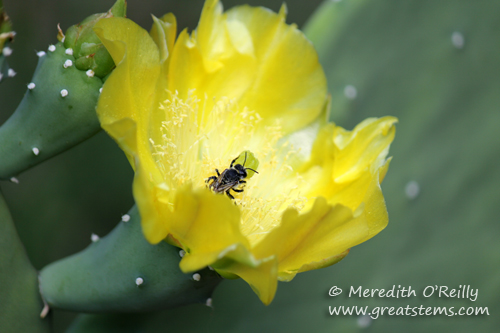
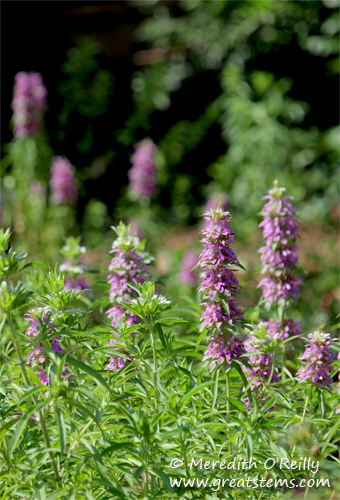
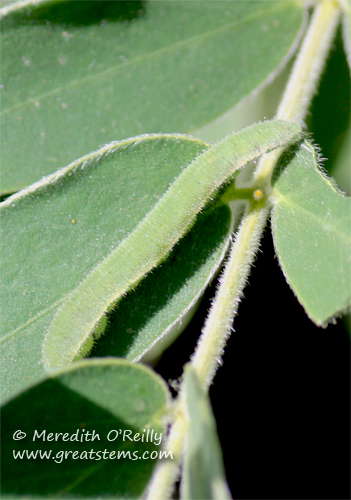
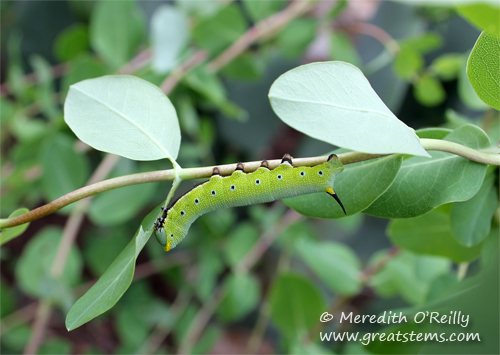
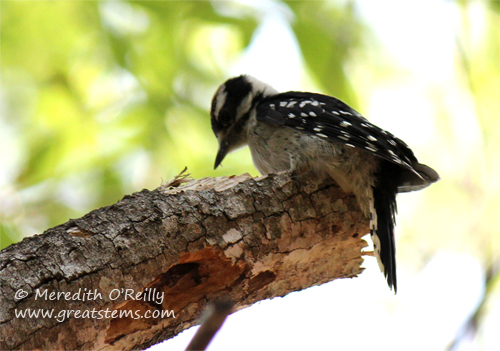
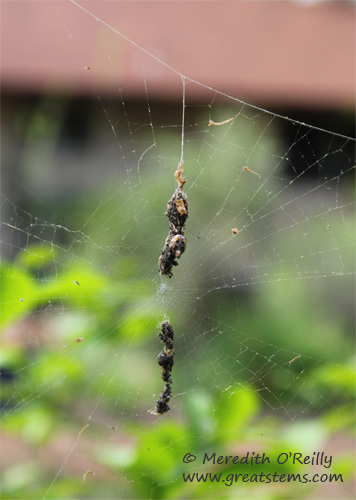
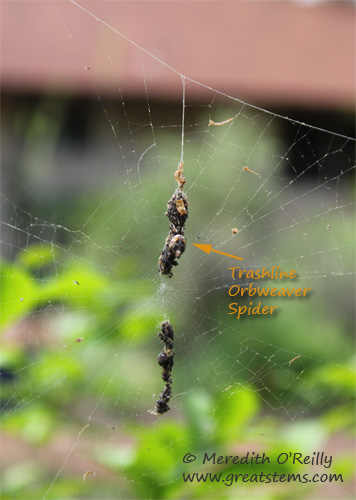
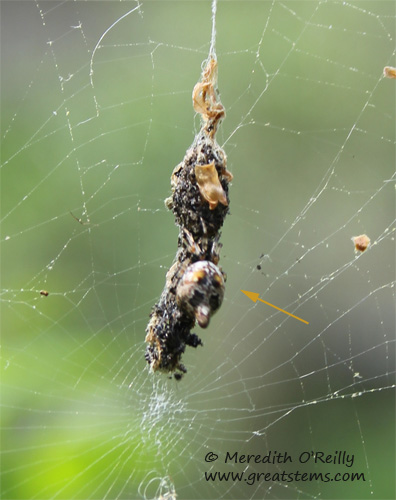

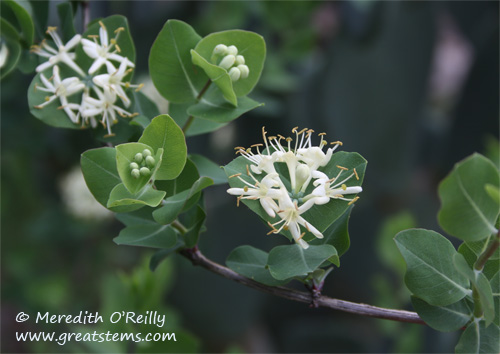
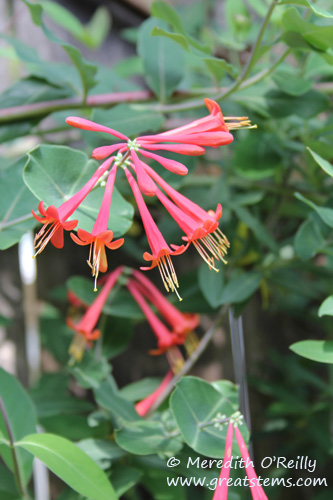
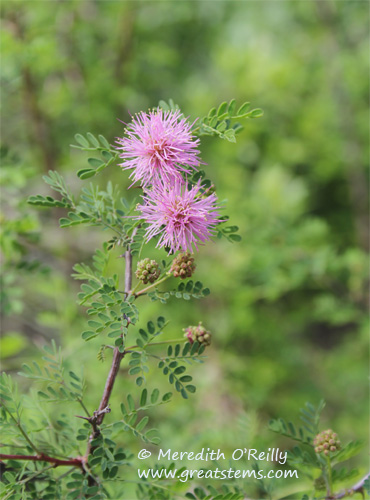
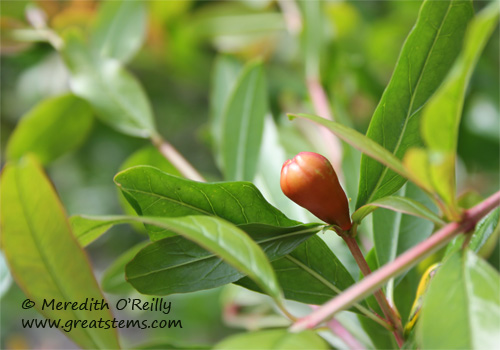
 What about the Blackfoot Daisies, twice as big as when I planted them before our trip?
What about the Blackfoot Daisies, twice as big as when I planted them before our trip?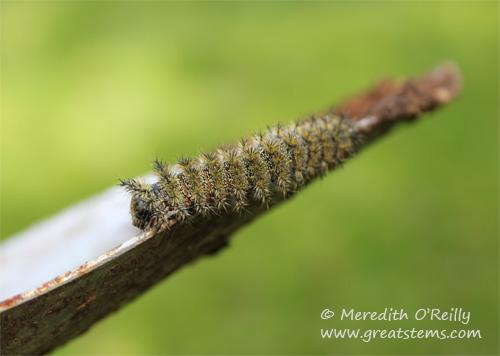






 As we were getting ready to leave, my husband called me over to see a creature hanging upside-down from the car of a volunteer. It turned out to be a gorgeous Lepidopteran.
As we were getting ready to leave, my husband called me over to see a creature hanging upside-down from the car of a volunteer. It turned out to be a gorgeous Lepidopteran.  Polyphemus moths have an average wing span of about 6 inches. As adults, they also have reduced mouth parts, meaning that they can’t eat, so they have one job to focus on: reproduction. The feathery antennae of the males are used to detect the scent of unmated females. Whether the antennae also make the male moths look sexy to females, I cannot attest. But for this female, I think they look pretty cool. Not getting to eat means something else — the moths have a short lifespan of less than a week.
Polyphemus moths have an average wing span of about 6 inches. As adults, they also have reduced mouth parts, meaning that they can’t eat, so they have one job to focus on: reproduction. The feathery antennae of the males are used to detect the scent of unmated females. Whether the antennae also make the male moths look sexy to females, I cannot attest. But for this female, I think they look pretty cool. Not getting to eat means something else — the moths have a short lifespan of less than a week. Perhaps because it was darker in the car, the moth came to life once we got moving on the road. By the time we were on the highway, it was fluttering all about, making for quite an interesting drive home. At one point, the Polyphemus moth decorated my husband as a bowtie.
Perhaps because it was darker in the car, the moth came to life once we got moving on the road. By the time we were on the highway, it was fluttering all about, making for quite an interesting drive home. At one point, the Polyphemus moth decorated my husband as a bowtie.

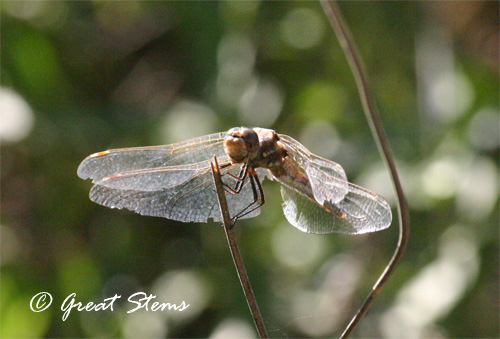
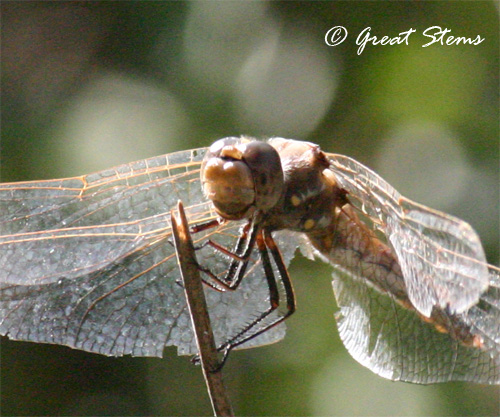
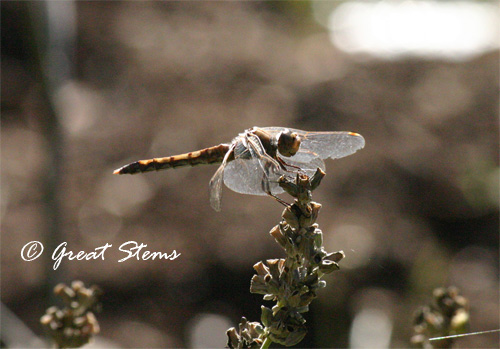
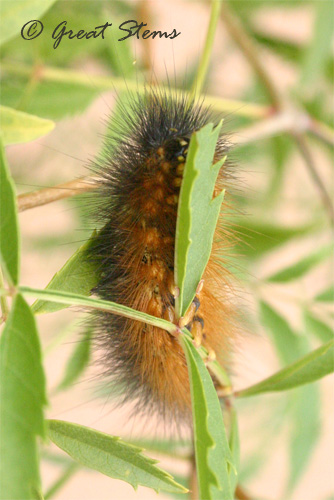
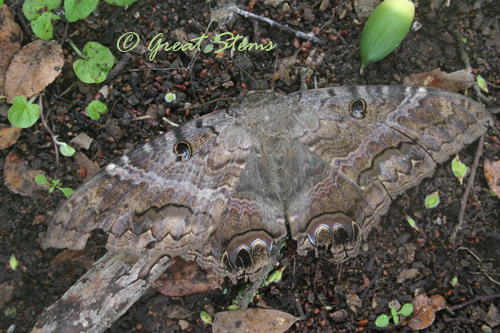
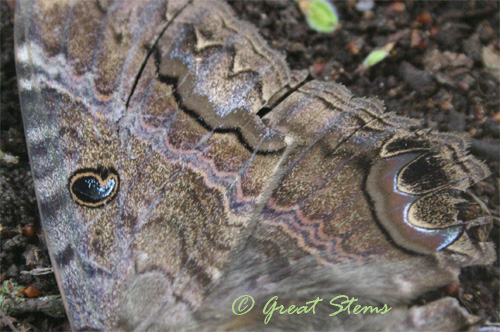
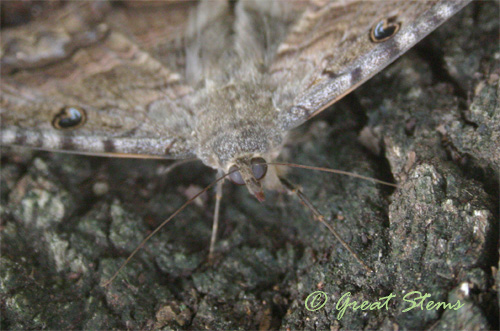
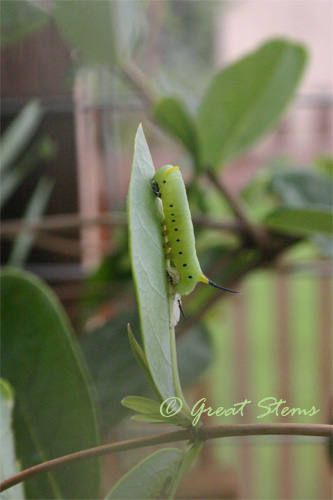
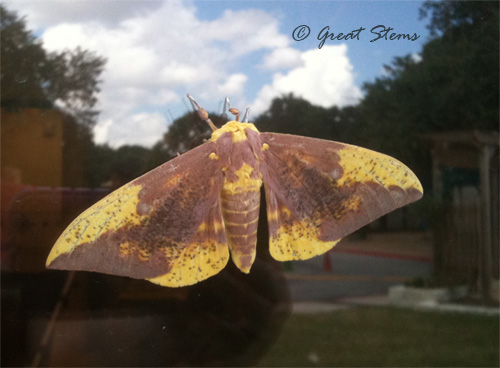
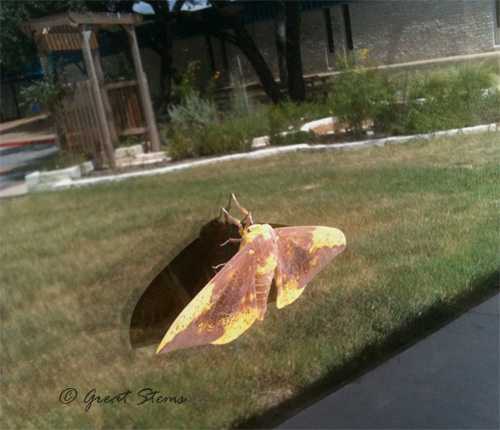
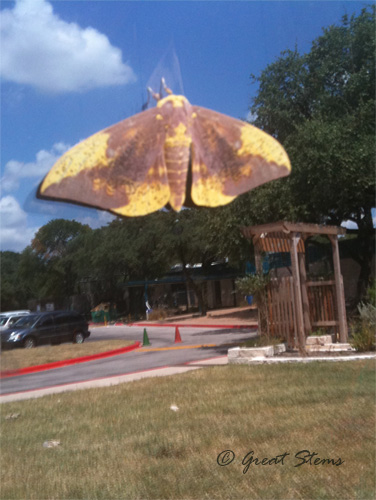
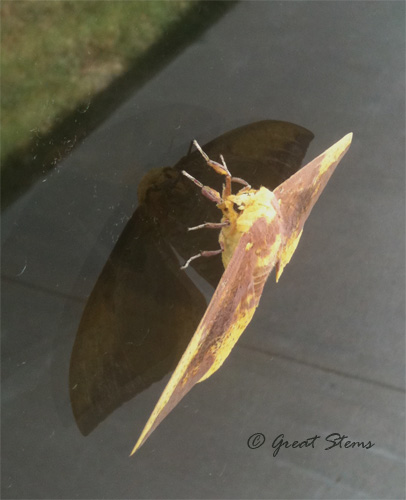
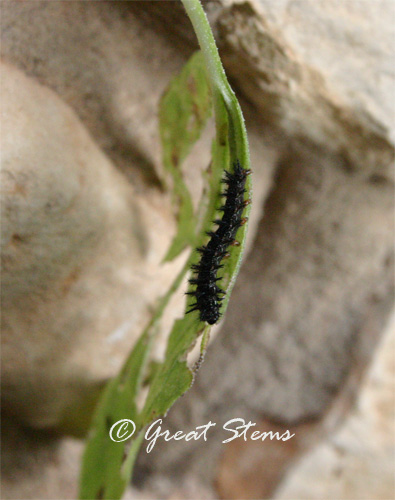

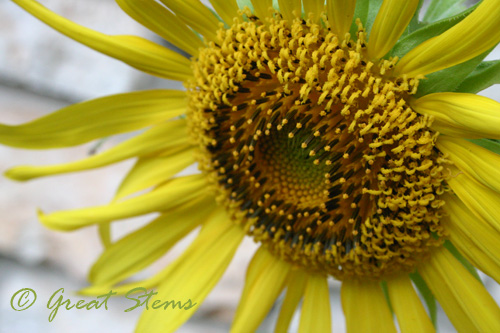
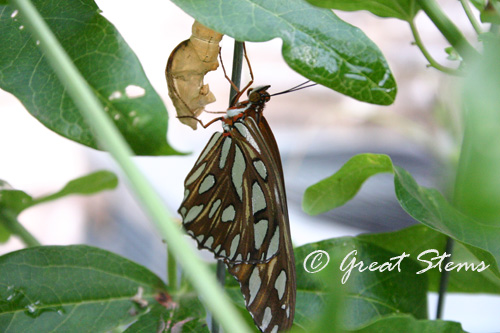
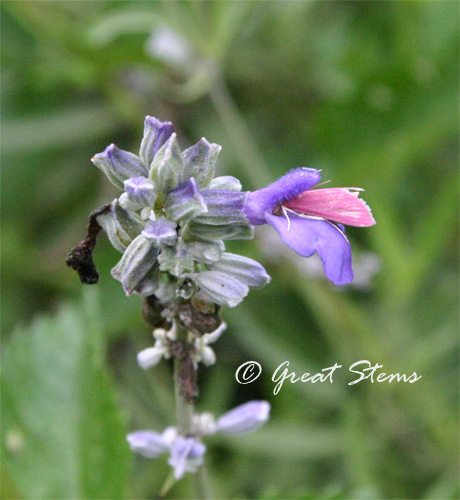 This next photo makes it look much darker than it really is — the moth is actually a very dainty pink. And dainty in size, too!
This next photo makes it look much darker than it really is — the moth is actually a very dainty pink. And dainty in size, too!